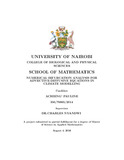| dc.contributor.author | Achieng, Pauline | |
| dc.date.accessioned | 2016-11-21T13:07:16Z | |
| dc.date.available | 2016-11-21T13:07:16Z | |
| dc.date.issued | 2016 | |
| dc.identifier.uri | http://hdl.handle.net/11295/97646 | |
| dc.description.abstract | The earth's climate system is a highly complex, interconnected system formed
by the atmosphere, land surface, ocean and snow together with all living organisms
and powered by the solar radiation. Mathematical models have been
developed to model the complex processes within the climate system which
include radiative, convective, advective and di usive processes. This models
range from simple models to complex models and they require tools to generate
the relevant information needed to understand the phenomenon behind
them. Therefore some of the tools used to study these model equations include
linear stability analysis and other dynamical system methods like the
numerical continuation method which we will use here to study bifurcation
for the advective-di usive models. | en_US |
| dc.language.iso | en | en_US |
| dc.publisher | University Of Nairobi | en_US |
| dc.rights | Attribution-NonCommercial-NoDerivs 3.0 United States | * |
| dc.rights.uri | http://creativecommons.org/licenses/by-nc-nd/3.0/us/ | * |
| dc.subject | Advective-Diffusive Equations In Climate Modelling | en_US |
| dc.title | Numerical Bifurcation Analysis For Advective-Diffusive Equations In Climate Modelling | en_US |
| dc.type | Thesis | en_US |



